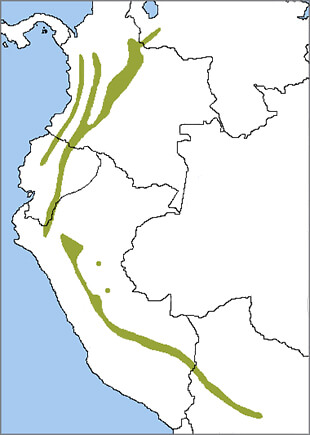 The male Andean Cock-of-the-rock is an unmistakable sight, with brilliant red-orange plumage, black-and-white wings, and a large fan-like crest that almost completely obscures its bill. Known as tunki in Quechua, this cotinga is the national bird of Peru and is related to other distinctive tropical fruit-eaters such as the Banded Cotinga, Long-wattled Umbrellabird, and Bearded Bellbird.
The male Andean Cock-of-the-rock is an unmistakable sight, with brilliant red-orange plumage, black-and-white wings, and a large fan-like crest that almost completely obscures its bill. Known as tunki in Quechua, this cotinga is the national bird of Peru and is related to other distinctive tropical fruit-eaters such as the Banded Cotinga, Long-wattled Umbrellabird, and Bearded Bellbird.
Cock-of-the-What?
Why is this bird called a"cock"? We can only guess that the male bird reminded early observers of a rooster. It's also hard to imagine a bird much cockier than this one! (Read on to learn about its elaborate display.)
The "rock" is easier to explain. True to its name, the Andean Cock-of-the-rock frequents rocky cliffs and ravines close to forest streams. Its genus name, Rupicola, is derived from Latin words meaning rock or cliff inhabiting, a nod to this bird's preferred nest sites.
Four subspecies are recognized, resident in Andean subtropical and cloud forest from Venezuela to Bolivia. Despite the males' vivid color, this bird is more often heard than seen, sounding off with weird, raspy clanks and croaks on the lek or in flight.
Elaborate Display
Aside from its distinctive appearance, the Andean Cock-of-the-rock is also known for its elaborate breeding displays. Like Greater Sage-Grouse and Greater Prairie-Chickens, males gather at communal gathering spots called leks, where they show off their bright plumage and smooth moves.
Once a group of males gathers, competitors perch in pairs or small groups to perform mock confrontational displays, which feature bowing, wing-flapping, head-bobbing, bill-snapping, and bizarre squeaking and grunting calls. They frantically redouble their display efforts when the rufous-brown females approach to assess their performances.
Listen to males at a lek:
(Audio by Robin Carter, XC259087. Accessible at www.xeno-canto.org/259087)
Once a female cock-of-the-rock has made her choice among displaying males and has mated, she leaves the lek to build her nest and raise young alone. True to her name, the female builds her nest of mud and plant material 10 to 40 feet above the ground on a cliff, large boulder, or even in a cave like an Oilbird.
Sign up for ABC's eNews to learn how you can help protect birds
Andean Cock-of-the-rock female by Vivek Khanzodé, www.birdpixel.com
Fruit-Feeding Forester
Like many other tropical birds including the Keel-billed Toucan and Hooded Berryeater, the Andean Cock-of-the-rock feeds mostly on fruit, supplemented with insects and small vertebrates. Inedible seeds and pits pass through these birds' digestive tracts, making these cotingas important seed dispersers that help maintain the health and diversity of tropical forests.
Cock-of-the-rock Conservation
Although its populations are considered in decline, the Andean Cock-of-the-rock remains widespread and is not considered to be in immediate danger. However, it remains vulnerable to habitat loss.
ABC's Reserve Network, which spans 14 countries and protects more than 1 million acres, preserves habitat for the Andean Cock-of-the-rock at 10 reserves. These include the Cerulean Warbler Reserve in Colombia; the Tapichalaca and Narupa Reserves in Ecuador; and the Abra Patricia and Huembo Reserves in Peru. More details on visiting any of these places can be found at the Conservation Birding website.
Donate to support ABC's conservation mission!



















































